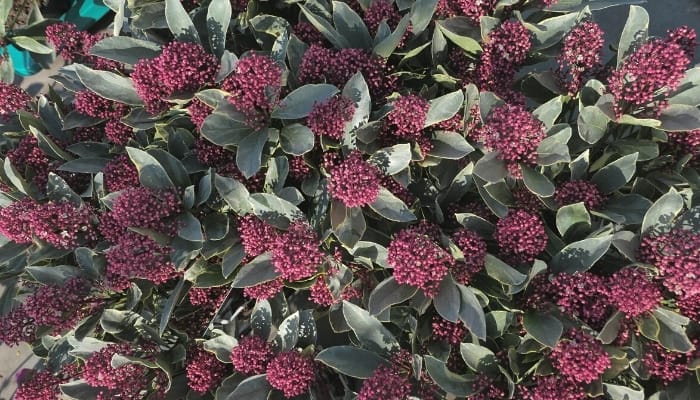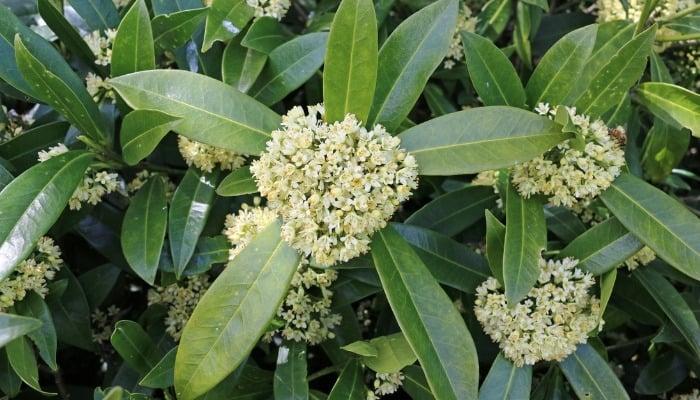Skimmia, a rugged evergreen shrub with white flowers and red berries, is typically found in temperate regions of Asia.
If you crush any part of the plant, including the light-green leaves, it will fill the air with a pungent aroma, but the leaves don’t remain green and healthy all the time. Sometimes, they turn yellow.
Why are my skimmia leaves yellow? When skimmia leaves turn yellow, check that the shrub is not getting too much sunlight or that the soil pH is not too alkaline, which would block the iron uptake. Poor soil and lack of nutrients can also cause the leaves to turn yellow, wither, and fall.
Sometimes, it will take more than one of these common causes to cause the leaves of the skimmia to turn yellow, so fixing one issue might not solve the problem.
You’ll need to go through the whole list, fixing each one of them to see if that solves the problem.
5 Causes (and Solutions) for Yellow Skimmia Leaves
Although the skimmia shrub is a hardy plant, it can show signs of stress when the growing conditions around it become inadequate or downright inhospitable.
From irregular watering to poor soil or fluctuating pH levels, the leaves are the first to alert you that all is not well with the skimmia.
If you notice the leaves are turning yellow, check for one or more of the following 5 causes.
#1. Too Much Sunlight
Of all the skimmia species that grow in the wild, only the Skimmia ‘Kew Green’ has a high tolerance for direct sun exposure.
The other species prefer their sunlight filtered, or better still, they like partial shade. Some species even grow in full shade without a problem.
So if you’re growing a species other than Skimmia ‘Kew Green’ and the leaves have turned yellow, check if the shrub is growing in full sunlight.
Solution
If the cause of the yellow leaves in skimmia is due to direct sunlight, consider growing a larger shrub or a tree next to the skimmia to cut off the sunlight or at least allow dappled light to pass through to the skimmia shrub.
Transplanting the plant to a shady spot facing the east or north in your garden is a better and more permanent solution.
#2. Incorrect Soil pH
The soil pH has a major role to play in the health and success of the skimmia shrub. For the most part, the plant prefers the soil to be slightly acidic.
If the acidity level goes up or drops too much, the sensitive roots won’t be able to absorb the necessary nutrients to keep the plant healthy.
Solution
Test the soil pH around the skimmia shrub at different times of the year, especially after heavy rainfall.
Use something like this test kit, which also can be used to test for nitrogen, phosphorous, and potassium.
Make sure that the pH levels are between 5.6 to 6.0. Amend the soil to bring the pH levels up or down until you reach this range.
#3. Not Enough Water
It’s not just the soil pH that affects the health of the shrub. Drought too can have a devastating impact on the plant overall.
For the most part, the shrub thrives in moist and well-draining soil. That means light but regular watering depending on the time of the year.
Solution
Test the top 1 inch of the soil with your finger to make sure it’s dry before watering the plant. Avoid irrigation in hot weather.
In the spring, water the skimmia in the morning. In the summer, wait for the temperature to cool down in the evening before watering it. Add mulch to improve water retention in the soil.
#4. Lack of Nutrients
Although the skimmia shrub is not exactly a heavy feeder, it still needs the bare minimum requirements of the basic nutrients nitrogen, phosphorus, and potassium to survive and stay green.
The absence of other elements, such as magnesium, can also make the leaves turn yellow.
Solution
Feed the skimmia with a fertilizer specific to acidic plants. A custom fertilizer with a label like 10-5-4 (find it here) will not change the soil pH.
Apply it once a year in the spring. If the soil is poor, you can apply the fertilizer again in the summer.
#5. Lime in Soil Is Blocking Iron Uptake
A high concentration of lime in the soil often translates into high pH levels. This can interfere with the ability of the roots of the skimmia to absorb precious nutrients such as iron.
Since the shrub loves slightly acidic soil, that can also impact its growth.
Solution
If you test your soil and find high levels of lime and increased pH levels, then treat the soil with sulfur.
This will increase the acidity and bring down the pH levels to the adequate 5.6 to 6.0 levels.

Skimmia Care
For the most part, you won’t have much trouble growing the skimmia shrub.
The hardy plant requires little water and sparse feeding, and as long as it doesn’t get more sunlight than it can tolerate, it will grow and thrive with little intervention on your part.
Planting & Ideal Soil
The shrub thrives in moist soil that drains well. Clay or heavy soil retains the water for too long while the compact texture prevents the roots from developing fully.
Amend the soil to make it loamy and fast-draining.
Light & Temperature
Except for the Skimmia ‘Kew Green’ species, all skimmia shrubs are shade-loving ones. They grow well in partial or even full shade.
So choose a spot in the garden facing the north or east that doesn’t get too much sunlight during the summer months.
The shrubs grow in moderate to slightly warmer temperatures in Zones 6 to 8.
Watering & Fertilizing
Water the shrub lightly when the temperature is cool. In the spring, water it in the morning, and in the summer give it water in the evening.
To feed it, apply a custom 10-5-4 fertilizer once a year in the spring.
Pruning
Most skimmia species have a slow and compact growth habit. That rules out the need for heavy or regular pruning. Still, light trimming to keep the shrub in shape may be required.
Related Question:
Can Yellow Leaves Turn Green Again?
Once you have fixed the cause of the yellowing leaves, most skimmia shrubs will regain their healthy and green appearance again by putting out new growth.
Any leaves that turned yellow, however, will eventually fall off; they will not turn green and thrive again.
Conclusion
When skimmia leaves turn yellow, that could mean the shrub is getting too much sun or the soil is too poor. Increased soil pH and drought can also cause the problem.
With proper care and regular light watering, the skimmia will become healthy once again.

